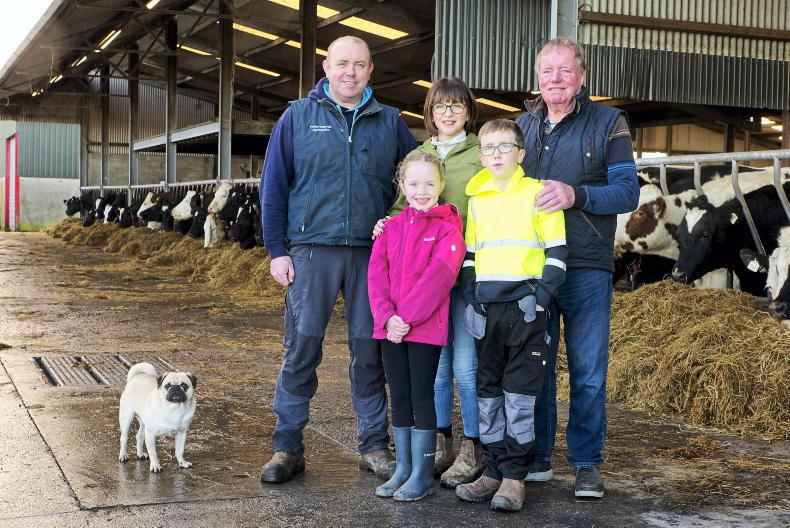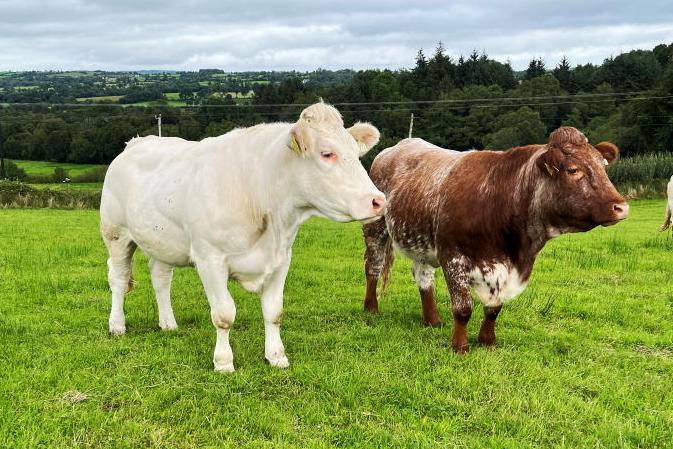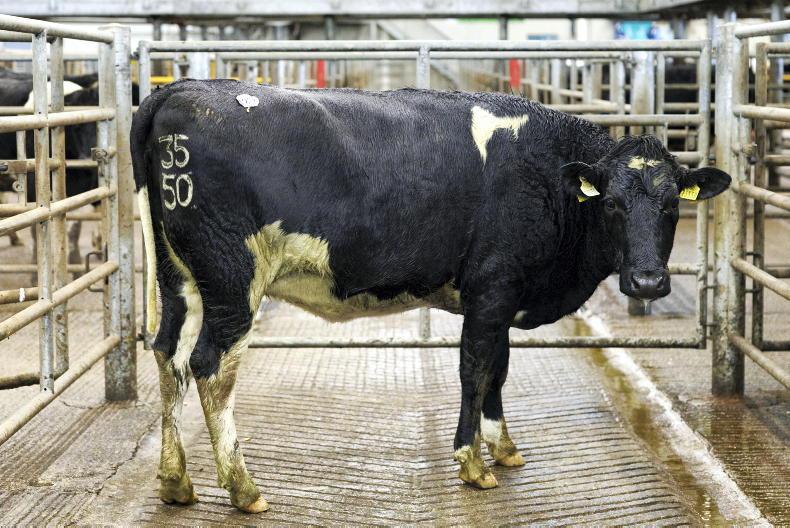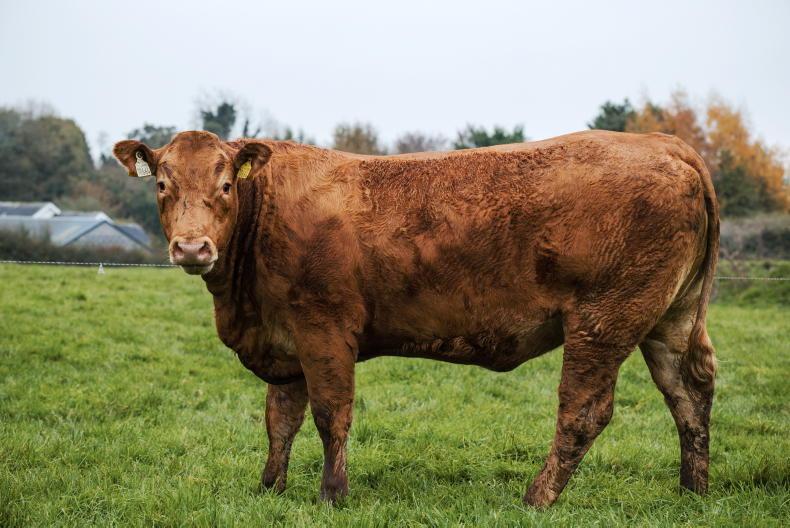When it comes to calving suckler replacements at 24 months of age, the first winter housing period for spring-born heifers will make or break the system.
Replacement heifers that are not separated for priority management in terms of feeding and lying space will struggle to gain enough liveweight during the housing period.
The end result is heifers that may be too small when served and under-developed by the time they calve down.
This increases the risk of heifers being stunted and not going back in-calf. Ultimately, these animals are culled with a low sale value, putting farmers off calving at 24 months of age.
Priority
On the flip side, under good management, heifers that thrive in the shed over winter tend to encounter fewer problems after they calve down for the first time.
This winter, there will be suckler farmers looking to control costs by offering maiden heifers a silage-only diet.
This is fine if there are large reserves of high-quality silage in store and spring turnout is possible in late February to early March.
But if this is not the case, then replacements will need supplementing with concentrates to keep heifers on track in terms of development.
Target weight gain
As a rule of thumb, heifers should weigh at least 60% of the average mature cow weight when bred and 90% of mature cow weight at calving time.
If mature cows weigh 750kg, this means heifers should weigh a minimum of 450kg when turned out to the bull.
In the case of a spring-calving herd with predominantly March- or April-born calves, heifers should weigh around 280kg to 320kg by mid-October.
Allowing two weeks to adjust to housing and weaning, heifers averaging 300kg liveweight on 1 November, with a target breeding weight of 450kg by 1 June, need to gain 150kg in 212 days.
Assuming turnout on 1 April and a daily gain of 1kg/day on spring grass, it means the heifers have to gain 90kg over a 150-day housing period, or a daily liveweight gain of 0.6kg/day.
Silage quality
This may not seem like an excessive weight gain target, but without high-quality silage in the region of 72 DMD or better, it can be difficult to achieve.
In reality, heifers are likely to gain 0.4kg to 0.5kg/day on a good-quality forage-only diet during the housing period. This makes an early turnout next spring important to avail of compensatory growth.
If silage is lower quality at 67 to 70 DMD, weight gain on a forage-only diet will likely be around 0.3kg to 0.4kg/day. Heifers will grow frame, but lack weight.
If weight gain averages 0.35kg/day, the example group of heifers will weigh 350kg by 1 April and unlikely to hit the 450kg target by 1 June.
Therefore, these animals will require 1.5kg to 2kg/day of concentrate to increase weight gain in line with the 0.6kg/day target when housed.
At a ration cost of €450/t, this will cost 90c/day. But if it yields a weight gain of 0.6kg/day, at a weanling value of €3/kg, the heifers are covering their winter feed costs.
Housing weight
Housing weight is also important. The heavier the housing weight, the less weight that has to be gained indoors and vice versa.
This makes weighing heifers at housing time an important job to complete. It should also be replicated midwinter to check animals are on track with weight gain and again at turnout.
Steps to calving at 24 months
Select replacements now and house early
The feed value of grazed grass is low in late autumn, so this year’s heifer calves destined for breeding should be housed early, then transitioned on to a growing diet to maintain weight gain.
Once housed, heifers can be weaned and ready to push on by the start of November.Delaying housing, and weaning, until late October will make it harder to meet target breeding weights next June.
Front loading concentrates
Front loading concentrates during the first half of the housing period is more likely to keep heifers on target in terms of weight gain over winter.
When front loading concentrates, the same quantity of concentrate is still fed as would be the case with a flat-rate method. For example, if meal is offered at a flat rate of 2kg/day over a 150-day winter, heifers will consume 300kg of concentrate. Front loading meal to 3kg/day over the first 75 days, before reducing to 1kg/day for the second 75 days, the animal still eats 300kg.
But heifers should be heavier mid-way through winter and more likely to meet target weight gain.
Housing space
Heifers that are overstocked in sheds will have weight gain greatly reduced. Heifers should be penned based on turnout weight, not housing weight. This reduces the risk of overstocking animals.
Parasite treatment
Once heifers are housed, treat for fluke, worms and lice as early as possible to increase weight gain. This means choosing a fluke product that targets early immature and mature fluke burdens.
Regular weighing
Regular weighing is recommended to check if heifers are on track to meet the weight target for breeding.If not, management can be altered in good time.
At the very least, heifers should be weighed at housing time, mid-winter and turnout.
Read more
Five options for weaning spring-born calves
Thrive weekly roundup: final grazing rotation and slaughter heifer performance
When it comes to calving suckler replacements at 24 months of age, the first winter housing period for spring-born heifers will make or break the system.
Replacement heifers that are not separated for priority management in terms of feeding and lying space will struggle to gain enough liveweight during the housing period.
The end result is heifers that may be too small when served and under-developed by the time they calve down.
This increases the risk of heifers being stunted and not going back in-calf. Ultimately, these animals are culled with a low sale value, putting farmers off calving at 24 months of age.
Priority
On the flip side, under good management, heifers that thrive in the shed over winter tend to encounter fewer problems after they calve down for the first time.
This winter, there will be suckler farmers looking to control costs by offering maiden heifers a silage-only diet.
This is fine if there are large reserves of high-quality silage in store and spring turnout is possible in late February to early March.
But if this is not the case, then replacements will need supplementing with concentrates to keep heifers on track in terms of development.
Target weight gain
As a rule of thumb, heifers should weigh at least 60% of the average mature cow weight when bred and 90% of mature cow weight at calving time.
If mature cows weigh 750kg, this means heifers should weigh a minimum of 450kg when turned out to the bull.
In the case of a spring-calving herd with predominantly March- or April-born calves, heifers should weigh around 280kg to 320kg by mid-October.
Allowing two weeks to adjust to housing and weaning, heifers averaging 300kg liveweight on 1 November, with a target breeding weight of 450kg by 1 June, need to gain 150kg in 212 days.
Assuming turnout on 1 April and a daily gain of 1kg/day on spring grass, it means the heifers have to gain 90kg over a 150-day housing period, or a daily liveweight gain of 0.6kg/day.
Silage quality
This may not seem like an excessive weight gain target, but without high-quality silage in the region of 72 DMD or better, it can be difficult to achieve.
In reality, heifers are likely to gain 0.4kg to 0.5kg/day on a good-quality forage-only diet during the housing period. This makes an early turnout next spring important to avail of compensatory growth.
If silage is lower quality at 67 to 70 DMD, weight gain on a forage-only diet will likely be around 0.3kg to 0.4kg/day. Heifers will grow frame, but lack weight.
If weight gain averages 0.35kg/day, the example group of heifers will weigh 350kg by 1 April and unlikely to hit the 450kg target by 1 June.
Therefore, these animals will require 1.5kg to 2kg/day of concentrate to increase weight gain in line with the 0.6kg/day target when housed.
At a ration cost of €450/t, this will cost 90c/day. But if it yields a weight gain of 0.6kg/day, at a weanling value of €3/kg, the heifers are covering their winter feed costs.
Housing weight
Housing weight is also important. The heavier the housing weight, the less weight that has to be gained indoors and vice versa.
This makes weighing heifers at housing time an important job to complete. It should also be replicated midwinter to check animals are on track with weight gain and again at turnout.
Steps to calving at 24 months
Select replacements now and house early
The feed value of grazed grass is low in late autumn, so this year’s heifer calves destined for breeding should be housed early, then transitioned on to a growing diet to maintain weight gain.
Once housed, heifers can be weaned and ready to push on by the start of November.Delaying housing, and weaning, until late October will make it harder to meet target breeding weights next June.
Front loading concentrates
Front loading concentrates during the first half of the housing period is more likely to keep heifers on target in terms of weight gain over winter.
When front loading concentrates, the same quantity of concentrate is still fed as would be the case with a flat-rate method. For example, if meal is offered at a flat rate of 2kg/day over a 150-day winter, heifers will consume 300kg of concentrate. Front loading meal to 3kg/day over the first 75 days, before reducing to 1kg/day for the second 75 days, the animal still eats 300kg.
But heifers should be heavier mid-way through winter and more likely to meet target weight gain.
Housing space
Heifers that are overstocked in sheds will have weight gain greatly reduced. Heifers should be penned based on turnout weight, not housing weight. This reduces the risk of overstocking animals.
Parasite treatment
Once heifers are housed, treat for fluke, worms and lice as early as possible to increase weight gain. This means choosing a fluke product that targets early immature and mature fluke burdens.
Regular weighing
Regular weighing is recommended to check if heifers are on track to meet the weight target for breeding.If not, management can be altered in good time.
At the very least, heifers should be weighed at housing time, mid-winter and turnout.
Read more
Five options for weaning spring-born calves
Thrive weekly roundup: final grazing rotation and slaughter heifer performance









SHARING OPTIONS